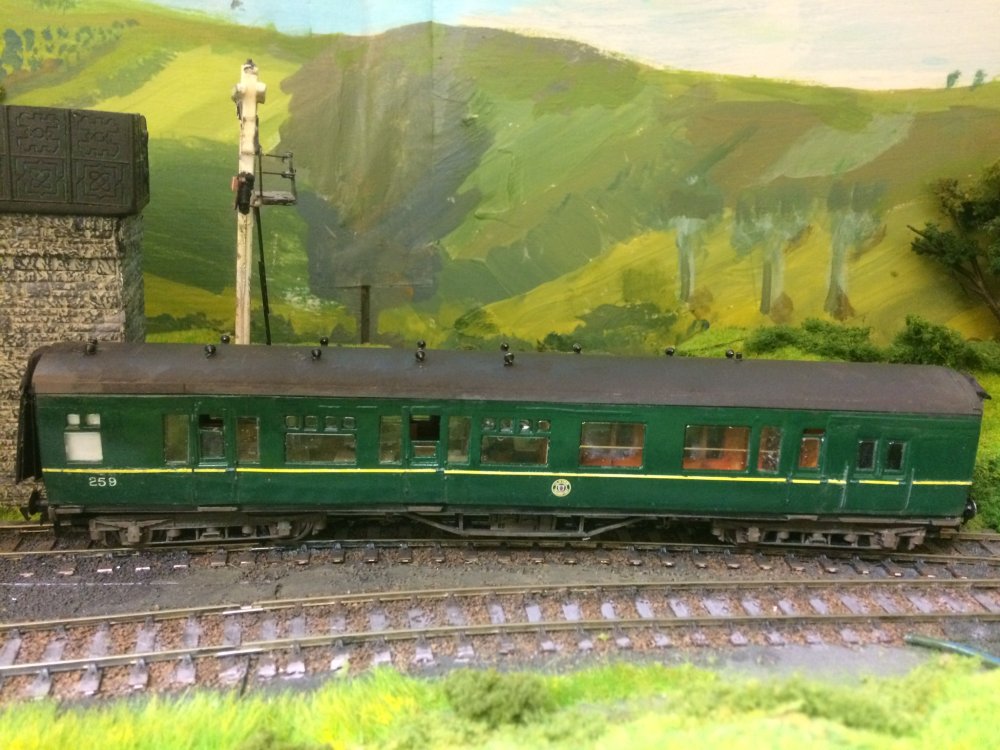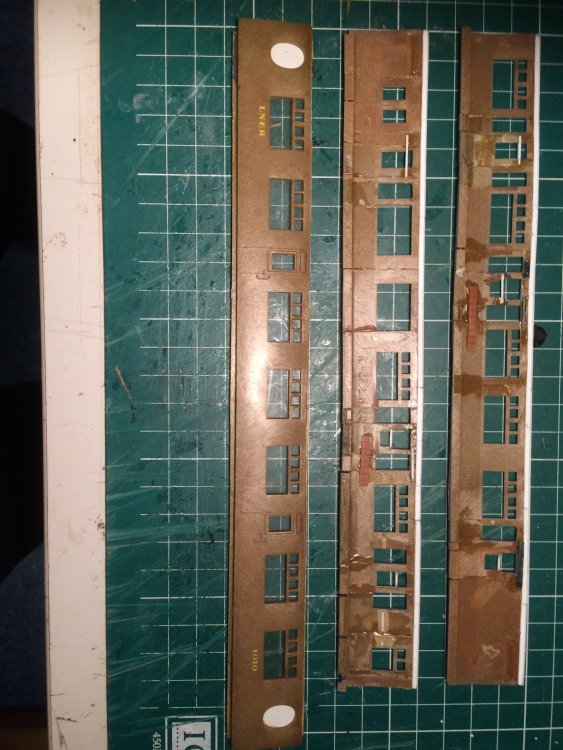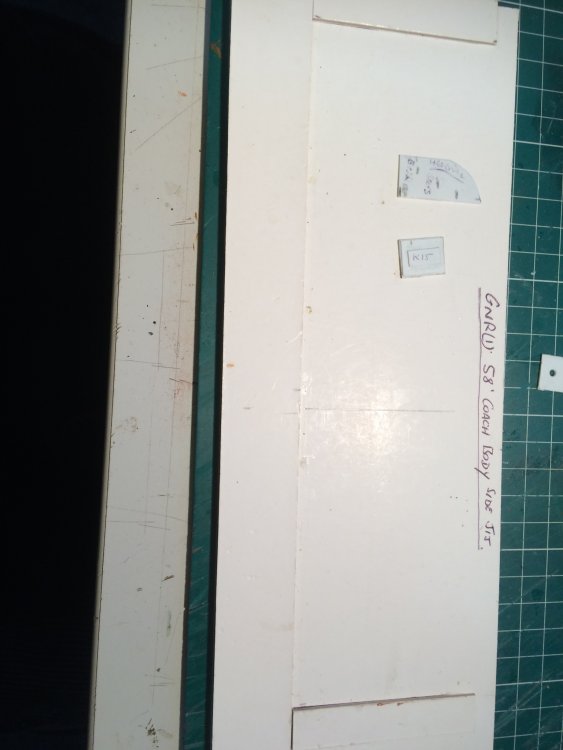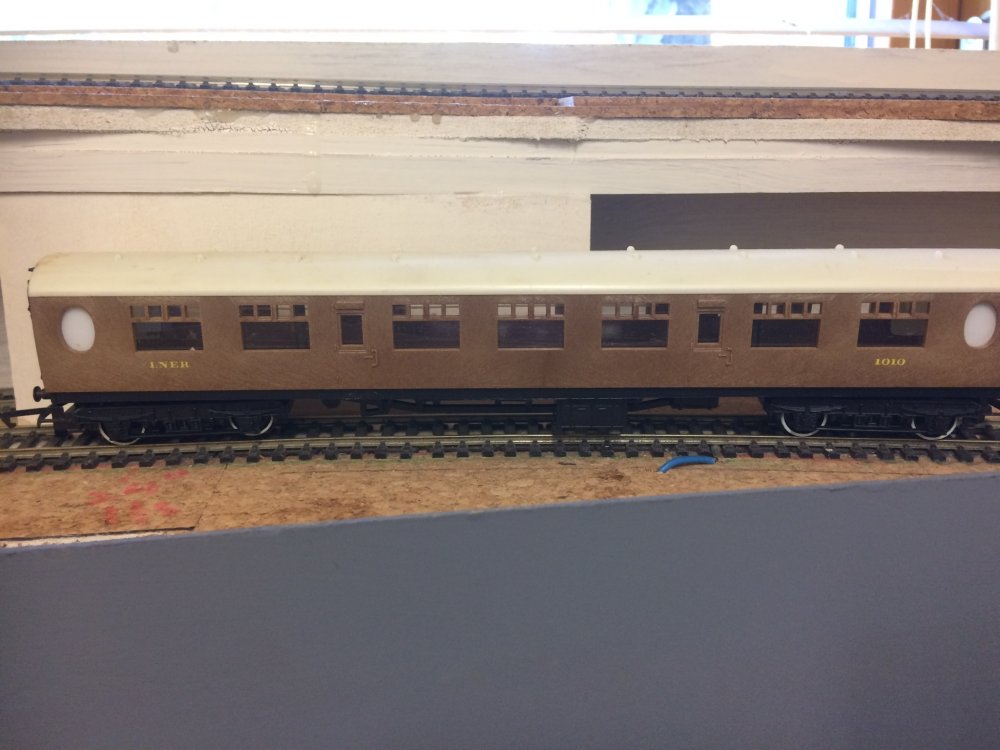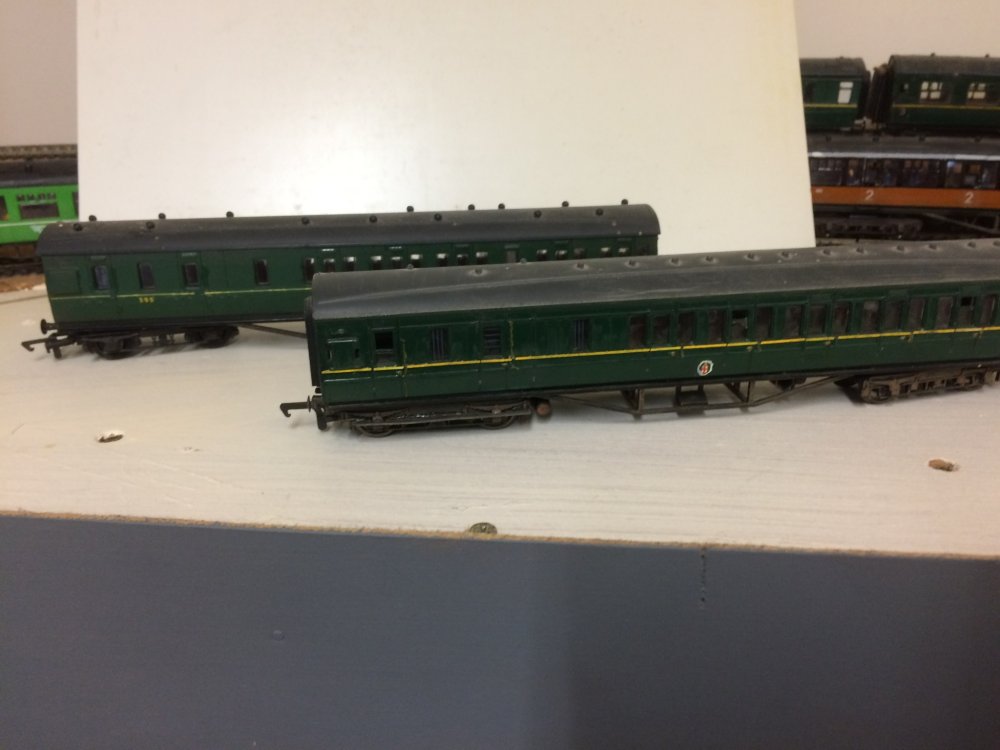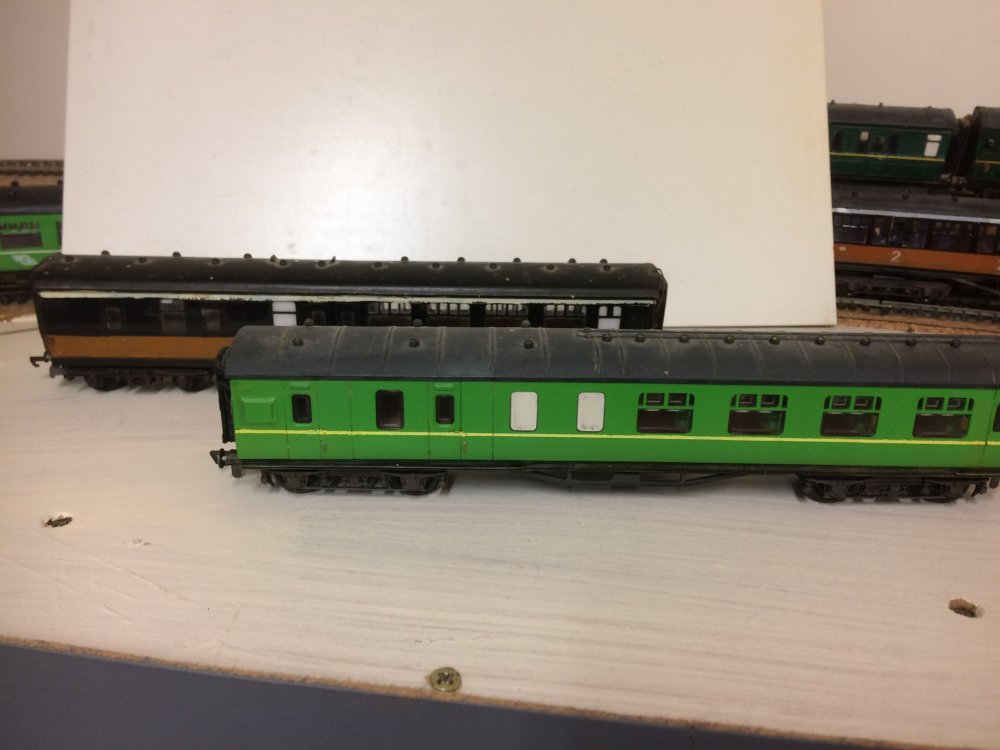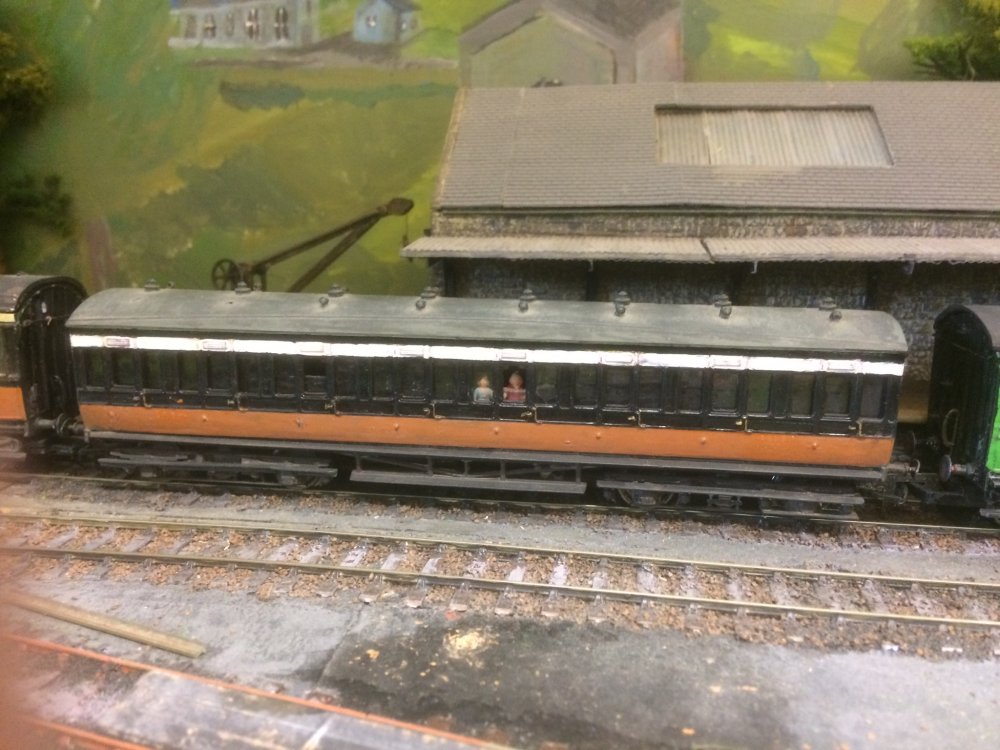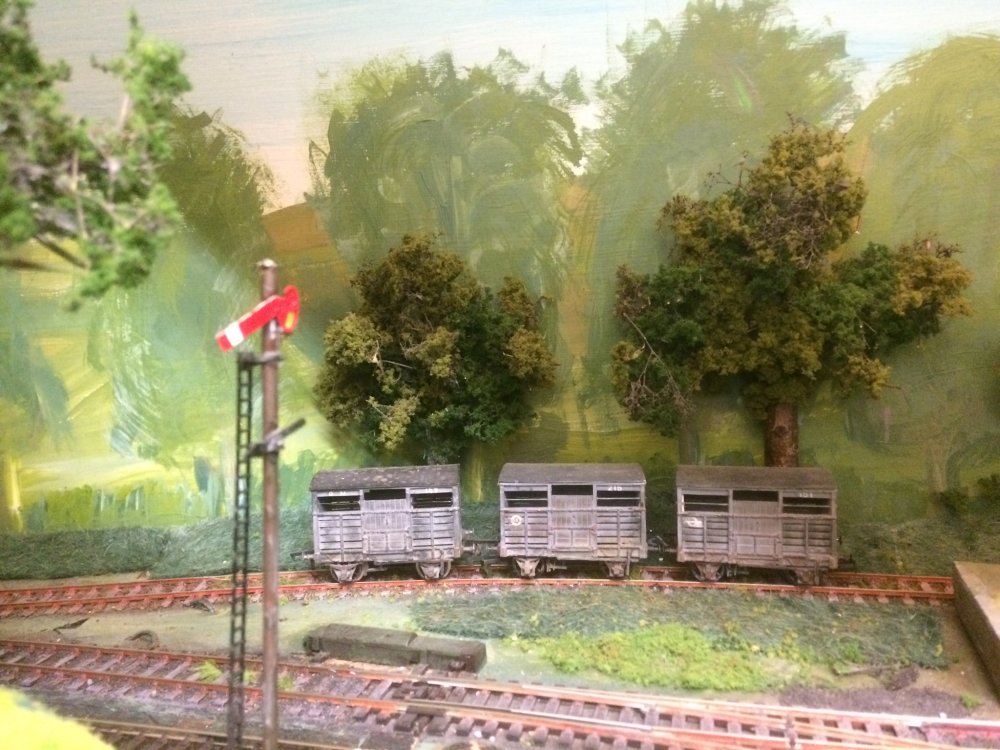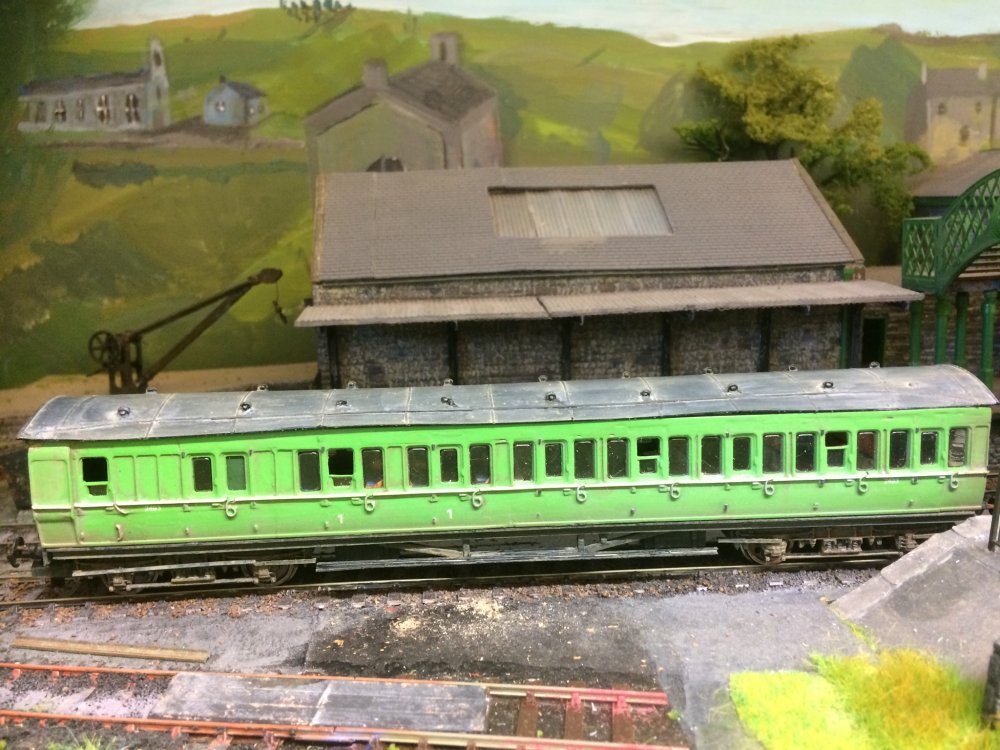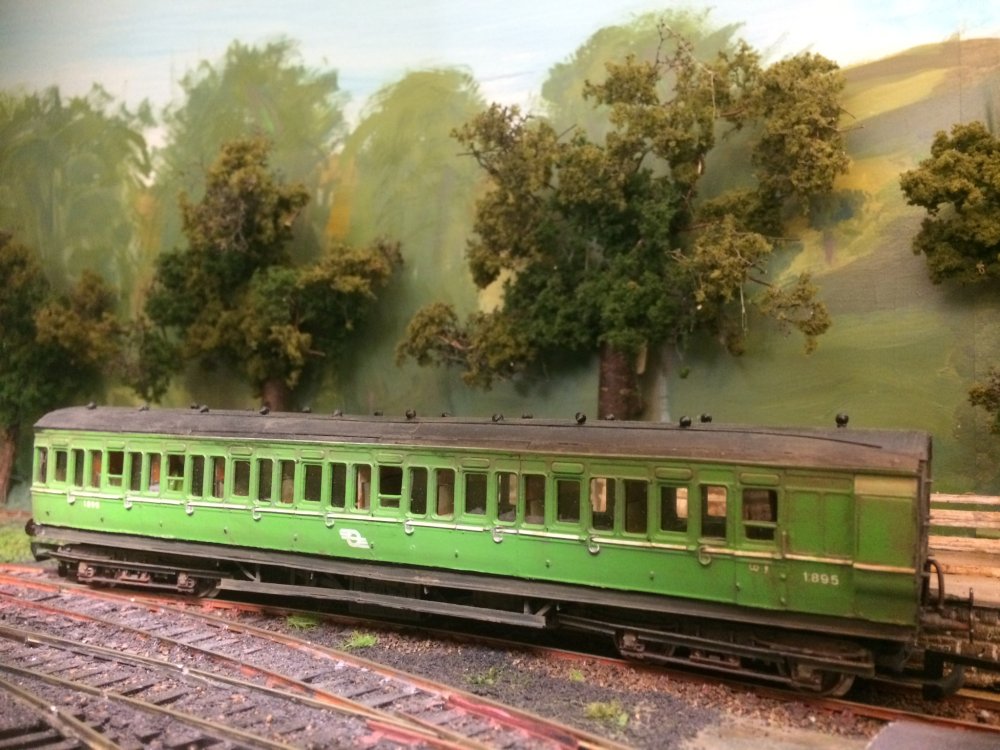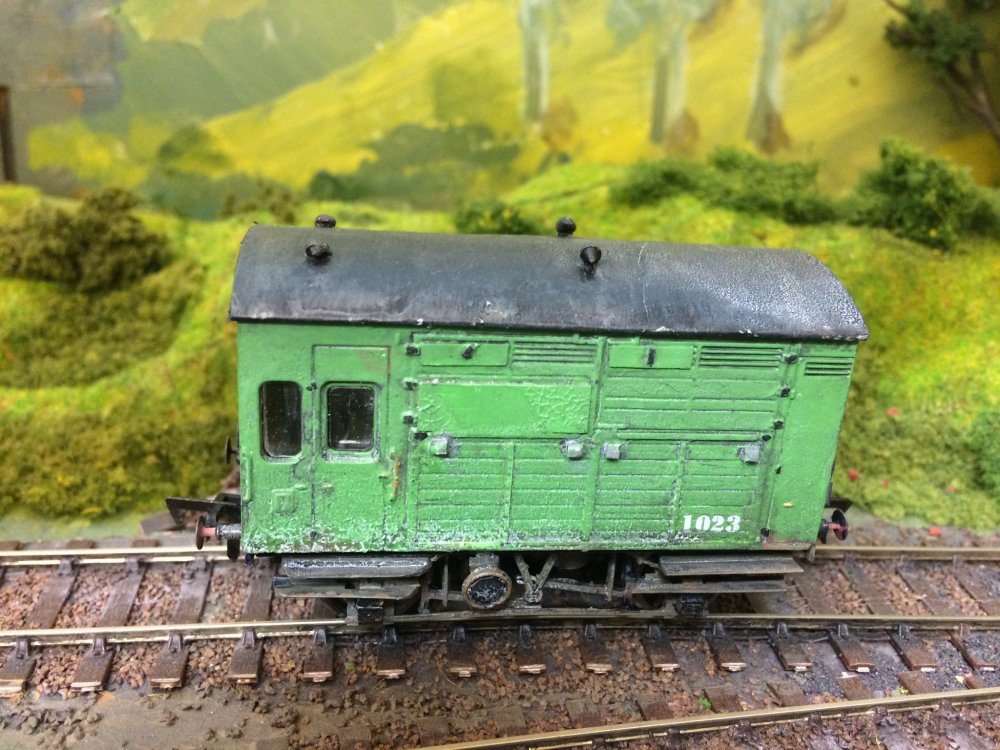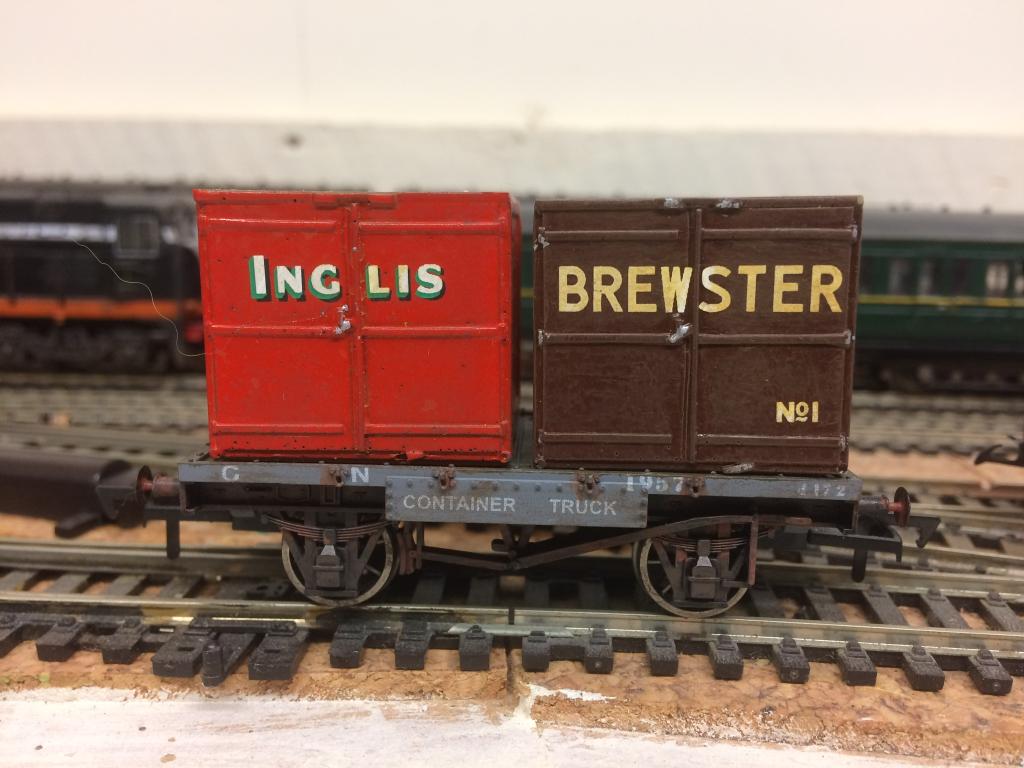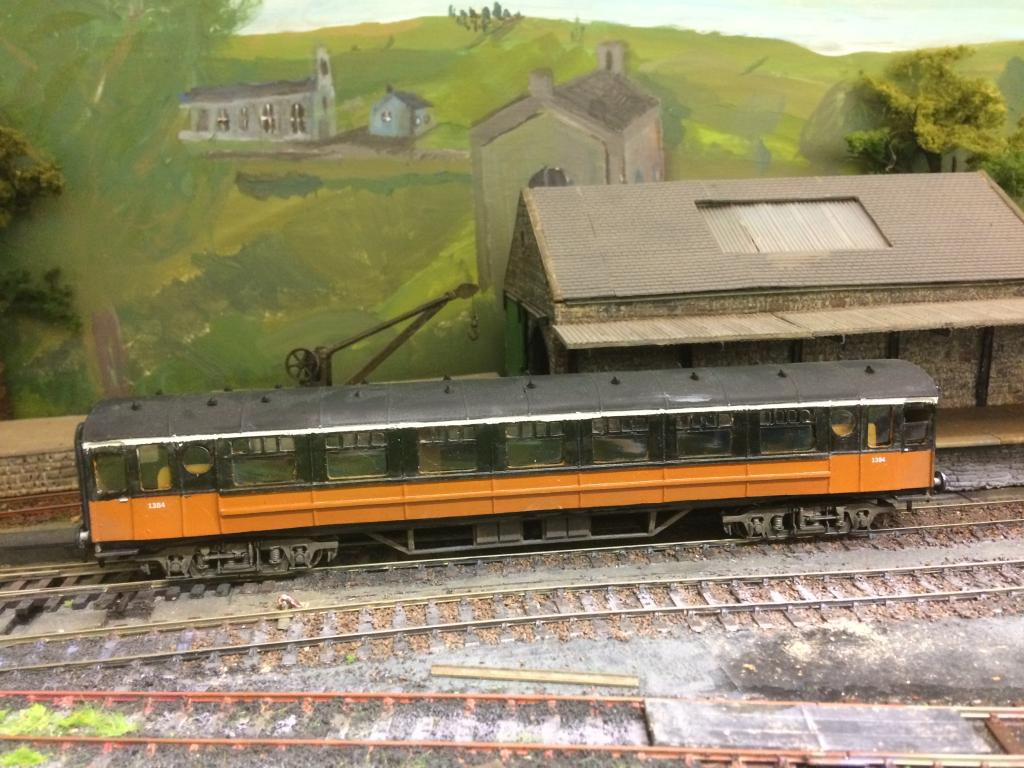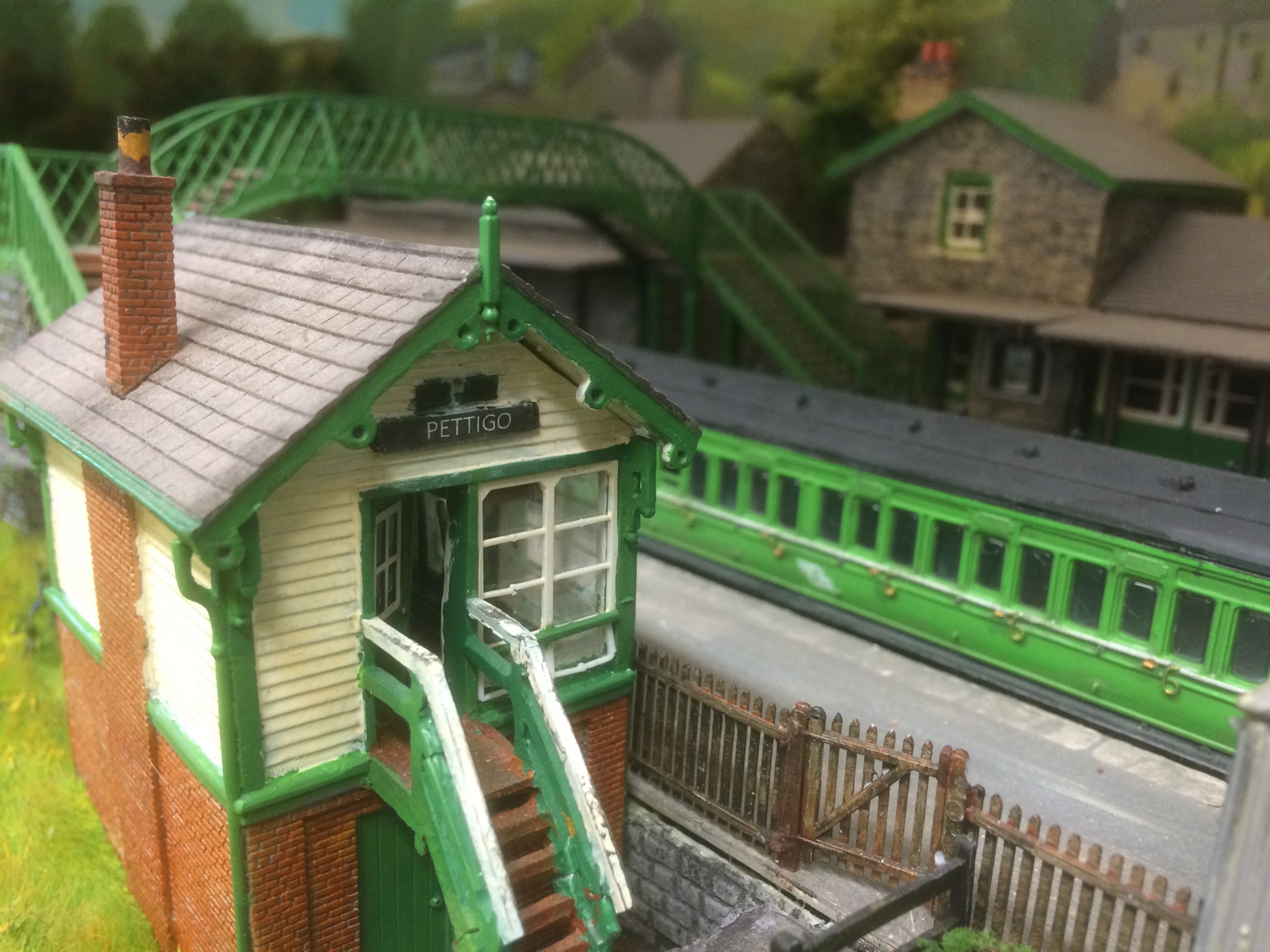
Glover
Members-
Posts
144 -
Joined
-
Last visited
-
Days Won
6
Content Type
Profiles
Forums
Events
Gallery
Blogs
Store
Community Map
Everything posted by Glover
-
John, I like the idea of what I would term a 'meandering' layout; well suited to the Sligo-Limerick, especially the northern end, the Burma Road. Can I suggest that stone walls are an absolute must! Glover
-
Now, before JHB jumps up and down, I do know that the yellow stripe should be a more beige type colour but I offer two excuses: 1. I have a few other UTA coaches, so for consistency I have stuck with yellow. 2. Colour photos from the UTA era 'appear' to show the stripe as being yellow. That may very well be a reflection of the quality of colour photography of that time. i have numbered it as 259. The correct number should be 258 but I simply didn't have the correct numeral. Can anyone recommend a source for UTA coach numerals? I have to say that I find the UTA green livery rather dull ( no offence to fans of the UTA.......) in 4mm scale. As a Dubliner, my exposure to the UTA was rather limited and I accept that it may have been more impressive in reality. You might ask if it would not have been better to make the damm thing from scratch . It's a moot point but using the Hornby sides does avoid having to make windows with sliding vents. Anyway, I now have a GNR J11 tricompo to run in one of the Bundoran Express's and an awful lot of spare parts...... Glover
-
Thanks Noel. I had to take a break there, to help get the bit of tea ready. After all of the cutting, making the ends, the under frame ( the bogies are Bachmann LMS) , the interior etc,etc , I finally ended up with this.......
-
I reckon there were about 14 major ( and more minor) cuts and rejoins required for each side. The major challenge is creating those small windows either side of the doors in the 3rd class section; painful. In fact actual blood was spilled; I should have taken a photo of that moment but it's hard to think of that when you're bleeding to death from a scalpel cut! Also meant that I had to add 'wipe blood from body side' to my own notes. For those of a strong constitution, here are some shots from the front line. Glover.
-
I am eternally grateful to those photographers in times past who paid as much attention to what came behind the engine and took careful notes. We should also thank the modern day publishers. In the case of the late Norman Johnson, they were in effect one and the same; Norman set up Colourpoint books, who have given us a range of books on Irish railways. In Normans' posthumous title, "Parting Shot", he published three photos of a GNR J11 tricompo, in service with the UTA in 1970. The GNR built three of these coaches in the late 1930s, primarily for service on the Derry Road. Incidently, lest anyone think I am some sort of walking expert on these matters, I have to point out that all me learnin' comes from books. The coaches were essentially in three parts: the guards'/luggage van, compartments, with a WC, for 1st and 2nd class and an open section for 3rd class. As I looked at the photos, it occurred to me that the third class open section was essentially a partial K15 coach. The K15 was the standard GNR coach; they built about 35 of them. And, I had a drawing of a K15, plus the information gleaned, I think, from Denis Coakham's book on Irish carriages that the van section was ten foot in length. Take these two basic bits of information plus the knowledge that the coaches were built to the standard GNR length of fifty eight feet, then I felt that I had a sporting chance of producing something from the Hornby coaches which might bear some resemblance to the originals. I was not being over ambitious ! Glover I'm writing this in sections (or dragging it out if you prefer!) simply to allow me to keep score. First thing I did was construct a jig for the body sides; just like those lads in Model Railway Journal! Mine was made from cardboard rather than some rare metal. It is necessary; there is a LOT of cutting and shutting involved in this project. Next comes the carnage...... Glover
-
Given that my layout, Pettigo, is set in GNR territory, I felt that ex-GNR coaches should feature heavily . This is more or less a given with the UTA coaches but the CIE trains were more likely to be a mix of Northern and CIE types. Many years ago, the guy working in the model shop in the Grafton Street arcade ( which was I believe the successor to the old Southern Models shop in a basement on Leeson St and which I think evolved over time to become the Marks Models of today), mentioned that the old Triangle/Hornby LNER Thompson coaches would make a fair representation of GNR coaches, given that they were issued in a wood grain livery. It was not an idea which appealed to me at the time and I certainly had doubts about the oval toilet windows. However, time passes..... For our younger readers, here is where we start. Glover
-
A little while ago, I decided that I needed to formulate a plan for coach building. To that end, I identified a need for six brake/passenger coaches: - 2X CIE for the Up and Down Bundoran Expresses - 2X UTA ( my model of Pettigo, Co Donegal assumes that the Bundoran branch, and the old Irish North Western, lasted until the summer of 1963 and that the practice of adding a coach, at Clones, which had come down from Belfast via Portadown and Armagh) continued. - 1X CIE for the branch train - 1X UTA for a local to Enniskillen. So, six in total. Current stock is four. In the photos below are two in CIE livery, the green one being the old Airfix LMS coach ( nice moulding but not really suitable) while the coach in black 'n tan is a very old Hornby Dublo model. I remember buying this in Helys on Dame Street in the early 1960s. Helys were stationaries and office suppliers but also had a toy department. I noticed recently that the Mercantile pub, who now occupy the ground floor, have opened a branch-bar next door, named Helys. When I mentioned this recently to a fellow Dub, he understood the reference immediately ! The UTA coaches are an old Graham Farish non-corridor coach which I bought from Colum Flanagan some time ago while the other is the Bachmann LMS wood panelled coach. The latter could be accepted, as the GNR did buy some old coaches from the LMS but the Graham Farish coach would probably be more suited to an NCC based layout. Anyway, net result is 6 required but only one to hand which might be suitable. More to come..... Glover
-
Does anybody in Dublin stock the Back Track magazine?
Glover replied to jhb171achill's question in Questions & Answers
Jhb, WH Smiths run the newsagents in Dublin Airport. I actually bought the February issue there two weeks ago; the article on the CDJR is an interesting take on the involvement of the Midland Railway. If you have no luck, PM me and I'll pass on my copy to you. Cheers, Glover -
The van shown in Mayners photo, sourced via Alan O'Rourke, is a heating van (HV), as also is the van in Irishswissernies' second photo, taken I think at Killarney. However, I am 99% certain that the van half hidden by B157 is a luggage van (LV). First time I've ever seen any indication that any of them ever received the green livery; thank you ! I might advance a theory why the HV's were more likely to be repainted: CIE operated a "heating season". HVs were stored during the summer months and thus were available for repainting whereas the LVs were in continuous use. Regards, Glover
-
Jhb, a question: were the 4 wheel luggage vans ever painted green? I thought they were unpainted/silver originally and then went into black & tan. i think I've seen a photo of a heating van in green but never a LV. Good luck with the layout; I'm sort off reminded of Richard Chowns' Castle Rackrent. Cheers, Glover
-
Thanks Garfield, I can now see how the CIE version is less complicated, more lightweight, as you say. Cheers, Glover
-
I was vaguely aware that the Commonwealth bogies used by CIE were different but I have to say that I struggle to see the differences. Maybe I just don't want to! Westhy/Des, while on the subject of bogies, any plans to make the GNR 10' bogies, as used under K15 coaches etc ? Cheers, Glover
-
Noel, General answer, based on photo evidence, is that the Bredins/early standard CIE coaches built in the early 1950s ran on GSR bogies. I use Bachmann LMS bogies to replicate these. Laminates, built from the mid '50s to early 60s appear to have been equipped with Commonwealth bogies. Again, Bachmann do these as spares. Hope this helps. Glover
-
The final coach in the excursion set is an Ian Kirk LNER kit, intended to represent some sort of GNR presence in the train. The kit was bought in the now gone Kings Cross model shop in London. I used to fly to London on business quite a lot in days gone by and often used the original Ryanair service from Dublin into Luton, on the BAC 1-11s. The journey involved a bus from Luton airport to the railway station and then train into a then somewhat shabby St Pancras. I always tried to create a spare 10/15 minutes at the end of the day, to go into the model shop across the road from Kings Cross station and therefore very close to St Pancras. The kit was built as intended. You will note the very prototypical broken window......no idea how that happened and the roof is glued in place! Glover
-
My excursion set is completed by two further coaches, both built a good many years ago. This is a Ratio Midland Railway all third. I remember buying the kit in the old and wonderful model shop in Phibsboro. I bought metal buffers from that treasure throve display on the counter. The original Ratio bogies gave up the ghost many years ago and were replaced by Bachman LMS bogies. It's really too short: it should be a 60 footer. It would be relatively straight forward to build to the correct length using two of the Ratio kits ( buy three kits and you should get two coaches) but it's not on my priority list at the moment. Glover
-
Thanks Eoin; got 'em! I've built two from Leslie's kits; the one on the left is a very old Model Wagon Company white metal kit; weights a ton! However, my layout, Pettigo on the GNR's Bundoran branch, is set in 1963 (assuming it remained open until then) and photographic evidence from that period suggests that virtually all the GNR vans which CIE inherited on the break up of the GNR had gone by then. Again, many thanks. Glover
-
Is that the GNR cattle wagon Eoin? I have built two of those plus an ancient white metal kit but I really need the CIE van; GNR wagons had a short life expectancy under CIE! Many thanks, Glover
-
At the other end of my non-corridor excursion set is a GSR brake/composite, based on the old faithful Hornby GWR coach. This project uses a mixture of the Hornby brake/3rd and the all passenger coach. This achieves the mix of compartment widths. I filed off the lower body panelling in order to replicate the plainer, compared to the GWR, appearance of GSR coaches. As before, the sides were increased in height. The ends, widened slightly, are from the Ratio GWR coaches which were going spare from the previous conversion. Note that the guards look out is at the very end of the coach, as per GSR practice. I made the roof years ago, from plastic, using the oft recommended method of curving under heat. Can't say it was a great success but I kept it in my scrap box. It's hour has come. I can justify the somewhat wonky appearance on the basis that the coaches were old, although not perhaps as old as you might think.... In 1931, the GSR built two brake/composites specifically for the Harcourt Street line. They were the only brake/compose built by the GSR. Because my coach is slightly different to the prototypes ( the Hornby compartments are somewhat wider than the rather cramped GSR ones: anyone fancy sitting in a 5'6" third class compartment with eleven other commuters? Even at rush hour, you would be more comfortable on the LUAS!). Anyway, I have numbered mine as 2493, assuming that the GSR built another couple of brake/compose to a slightly different configuration.
-
I started this thread with some notes on a GSR non-corridor coach, based on the old Hornby GWR clearstory coach. I have now added two coaches to what I see as an excursion/GAA special on the Bundoran branch. This is a form of 'back to the future' modelling. In the very late 1960s/early '70s, CIE assembled a set of old wooden bodied, non-corridor stock to run on the suburban services to Bray, usually hauled by an A class diesel loco. The train was a great favourite of the photographer Michael Baker who featured it in a number of his books. The basis is the Ratio GWR 4 wheel coaches. I had a number of body panels left over from the previously featured GSWR/GSR 6 wheel guards/luggage van. The ends were widened and the height of the sides increased in order to achieve that 'bigger' look of Irish coaches . I have numbered it 1895, to replicate the series of brake/3rds built in 1927 with the shorter guards section. Cheers, Glover
-
I see that I have not added anything to this posting since March of this year but I have been busy! In a previous post, I included a shot of a horse box, based on the old Lima model. I had another one kicking around which I shortened a number of years ago and decided to complete it. The planked ends are from the Evergreen #4083 sheet, the roof from a spare Parkside kit but widened while the under frame is again from Parkside. Actually finding photographs of these vans is not easy; from my reasonably extensive library I could only find one useful photo. I used this to add a little detail to the body sides: strapping on the drop down doors and plating over some of the vents on the upper part of body. I have numbered it 1023 on one side and 1035 on the other. Both vans were used in the Bertram Mills circus train in the summer of 1964 (source: Irish Railfans News October 1964). That train would make a fascinating project; it toured all over Ireland with GNR 20 ton vans being used to transport the elephants! Cheers, Glover
-
This must rate as some of the best ever modelling seen on this site, especially when you bear in mind that the starting point is a set of basic brass etches. Having built (just) two coaches from Worsley Works etches, I can begin to appreciate just how much hard work was involved here. The finish is superb. And to think all of this was achieved in less than two months; amazing! Glover Ps: thanks for the response re the goods shed and the signal attached to it.
-
This hardly merits inclusion in a workbench thread but I'll include it as the background research might be of some use to others. It's the Provincial Wagons GNR flat with bread containers. Apart from some weathering and removing the brake shoes from the right hand side, it's the standard product. The GNR are reputed to have developed this as a new traffic post WW2, although the NCC also offered the service. The containers were loaded at the bakeries and brought to the GNR goods yards in Belfast and Derry for onward carriage on goods trains. They were then returned in the afternoon. Pre the Anglo-Irish Free Trade Agreement ( mid/late 1960s), bakeries in Northern Ireland could not sell their products in the Republic of Ireland and vice versa. It was protectionism. Therefore, while a bread container could be seen passing through Pettigo, it would have to be destined for a town in NI. The only town of any size after Pettigo was Belleek. The only photo I could find was a Brewsters' container in Belleek. Brewster were I believe a Derry/Londonderry bakery while Inglis were I think based in Belfast. On that basis, the Inglis container is probably inappropriate. I don't suppose we have any experts on the Northern Ireland bakery business on the forum........ Regards, Glover
-
The Park Royal coaches are a key element on any Irish model railway from the mid/late 1950s to......( I've forgotten when they went out of service!). I have always wanted some of them but they are a difficult coach to model. The Worsley Works sides and ends are a possibility but they require a lot of work ( I've built two of their coaches). Scratch building coaches is a pain; done that too. Therefore, the Irish Freight Models Park Royals represented a realistic route to achieving my wishes. Buy them as kits (very easy to assemble) and paint them. This is modelled as the mainline variant, with toilet. Paintwork is slightly grubby; my model is set in 1963, so this coach would have been well due for a repaint into the then new 'black and tan' livery, as below. This is the suburban version with seating in the flat sided vestibule end sections. I'm well pleased. Glover
-
One subject you might raise with Mr McGrew Tony, is the bread container traffic. This was an interesting part of GNR operations ( and on the NCC section too, I believe). Does he have any particular memories of this traffic, including the bakeries which served Omagh? Very many thanks, Glover
-
I love that goods shed Kirley; looks very MGWR? I seem to remember a photo showing a signal attached to a goods shed, possibly on the Sligo line; Longford perhaps? Cheers, Glover
.png.c363cdf5c3fb7955cd92a55eb6dbbae0.png)
